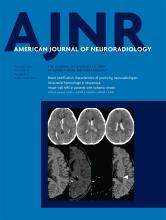Index by author
Shelerud, R.A.
- FELLOWS' JOURNAL CLUBSpine Imaging and Spine Image-Guided InterventionsYou have accessComparison of [18F] FDG-PET/MRI and Clinical Findings for Assessment of Suspected Lumbar Facet Joint Pain: A Prospective Study to Characterize Candidate Nonanatomic Imaging Biomarkers and Potential Impact on ManagementV.T. Lehman, F.E. Diehn, S.M. Broski, M.A. Nathan, B.J. Kemp, N.B. Larson, R.A. Shelerud, J.S. Brault, M.P. Halasy and T.P. MausAmerican Journal of Neuroradiology October 2019, 40 (10) 1779-1785; DOI: https://doi.org/10.3174/ajnr.A6224
Ten patients with clinically suspected facetogenic low back pain were prospectively recruited with a designation of specific facet joints implicated clinically. Subsequently, patients underwent an FDG-PET/MR imaging examination with gadolinium. Each facet joint was graded for perifacet signal change on MR imaging and FDG activity. The frequency and correlation of MR imaging, FDG-PET, and clinical findings were determined. There was low concordance of perifacet signal change and FDG activity with clinically implicated facet joints. This could indicate either the potential to change patient management or a lack of biomarker accuracy.
Shimoji, K.
- Adult BrainOpen AccessWhite Matter Abnormalities in Multiple Sclerosis Evaluated by Quantitative Synthetic MRI, Diffusion Tensor Imaging, and Neurite Orientation Dispersion and Density ImagingA. Hagiwara, K. Kamagata, K. Shimoji, K. Yokoyama, C. Andica, M. Hori, S. Fujita, T. Maekawa, R. Irie, T. Akashi, A. Wada, M. Suzuki, O. Abe, N. Hattori and S. AokiAmerican Journal of Neuroradiology October 2019, 40 (10) 1642-1648; DOI: https://doi.org/10.3174/ajnr.A6209
Shor, N.
- Adult BrainYou have accessMultinodular and Vacuolating Posterior Fossa Lesions of Unknown SignificanceA. Lecler, J. Bailleux, B. Carsin, H. Adle-Biassette, S. Baloglu, C. Bogey, F. Bonneville, E. Calvier, P.-O. Comby, J.-P. Cottier, F. Cotton, R. Deschamps, C. Diard-Detoeuf, F. Ducray, L. Duron, C. Drissi, M. Elmaleh, J. Farras, J.A. Garcia, E. Gerardin, S. Grand, D.C. Jianu, S. Kremer, N. Magne, M. Mejdoubi, A. Moulignier, M. Ollivier, S. Nagi, M. Rodallec, J.-C. Sadik, N. Shor, T. Tourdias, C. Vandendries, V. Broquet and J. Savatovsky for the ENIGMA Investigation Group (EuropeaN Interdisciplinary Group for MVNT Analysis)American Journal of Neuroradiology October 2019, 40 (10) 1689-1694; DOI: https://doi.org/10.3174/ajnr.A6223
Siebert, E.
- NeurointerventionYou have accessLow-Profile Intra-Aneurysmal Flow Disruptor WEB 17 versus WEB Predecessor Systems for Treatment of Small Intracranial Aneurysms: Comparative Analysis of Procedural Safety and FeasibilityL. Goertz, T. Liebig, E. Siebert, M. Herzberg, L. Pennig, M. Schlamann, J. Borggrefe, B. Krischek, F. Dorn and C. KabbaschAmerican Journal of Neuroradiology October 2019, 40 (10) 1766-1772; DOI: https://doi.org/10.3174/ajnr.A6183
Silver, F.L.
- EDITOR'S CHOICEAdult BrainYou have accessDiagnostic Impact of Intracranial Vessel Wall MRI in 205 Patients with Ischemic Stroke or TIAJ.D. Schaafsma, S. Rawal, J.M. Coutinho, J. Rasheedi, D.J. Mikulis, C. Jaigobin, F.L. Silver and D.M. MandellAmerican Journal of Neuroradiology October 2019, 40 (10) 1701-1706; DOI: https://doi.org/10.3174/ajnr.A6202
This was a single-center, retrospective study of 205 consecutive patients who were referred for vessel wall MR imaging to clarify the etiology of an ischemic stroke or TIA. An expert panel classified stroke etiology before and after incorporating vessel wall MR imaging results using a modified Trial of Org 10172 in Acute Stroke Treatment system. Vessel wall MR imaging altered the etiologic classification in 55% (112/205) of patients. The proportion of patients classified as having intracranial arteriopathy not otherwise specified decreased from 31% to 4% (64/205 versus 9/205) and the proportion classified as having intracranial atherosclerotic disease increased from 23% to 57%. When vessel wall MR imaging is performed to clarify the etiology of a stroke or TIA, it frequently alters the etiologic classification, which is the basis for therapeutic decision-making.
Soltys, S.G.
- FELLOWS' JOURNAL CLUBAdult BrainYou have accessPerfusion MRI-Based Fractional Tumor Burden Differentiates between Tumor and Treatment Effect in Recurrent Glioblastomas and Informs Clinical Decision-MakingM. Iv, X. Liu, J. Lavezo, A.J. Gentles, R. Ghanem, S. Lummus, D.E. Born, S.G. Soltys, S. Nagpal, R. Thomas, L. Recht and N. FischbeinAmerican Journal of Neuroradiology October 2019, 40 (10) 1649-1657; DOI: https://doi.org/10.3174/ajnr.A6211
Forty-seven patients with high-grade gliomas (primarily glioblastoma) with recurrent contrast-enhancing lesions on DSC-MR imaging were retrospectively evaluated after surgical sampling. Histopathologic examination defined treatment effect versus tumor. Normalized relative CBV thresholds of 1.0 and 1.75 were used to define low, intermediate, and high fractional tumor burden classes in each histopathologically defined group. Performance was assessed with an area under the receiver operating characteristic curve. Mean low fractional tumor burden, high fractional tumor burden, and relative CBV of the contrast-enhancing volume were significantly different between treatment effect and tumor with tumor having significantly higher fractional tumor burden and relative CBV and lower fractional tumor burden. High fractional tumor burden and low fractional tumor burden define fractions of the contrast-enhancing lesion volume with high and low blood volume, respectively, and can differentiate treatment effect from tumor in recurrent glioblastomas. Fractional tumor burden maps can also help to inform clinical decision-making.
Song, J.W.
- Adult BrainYou have accessImpact of Vessel Wall MR Imaging in the Work-Up for Ischemic StrokeJ.W. SongAmerican Journal of Neuroradiology October 2019, 40 (10) 1707-1708; DOI: https://doi.org/10.3174/ajnr.A6241
Suri, J.S.
- Extracranial VascularYou have accessCarotid Intraplaque-Hemorrhage Volume and Its Association with Cerebrovascular EventsL. Saba, G. Micheletti, W. Brinjikji, P. Garofalo, R. Montisci, A. Balestrieri, J.S. Suri, J.K. DeMarco, G. Lanzino and R. SanfilippoAmerican Journal of Neuroradiology October 2019, 40 (10) 1731-1737; DOI: https://doi.org/10.3174/ajnr.A6189
Suzuki, M.
- Adult BrainOpen AccessWhite Matter Abnormalities in Multiple Sclerosis Evaluated by Quantitative Synthetic MRI, Diffusion Tensor Imaging, and Neurite Orientation Dispersion and Density ImagingA. Hagiwara, K. Kamagata, K. Shimoji, K. Yokoyama, C. Andica, M. Hori, S. Fujita, T. Maekawa, R. Irie, T. Akashi, A. Wada, M. Suzuki, O. Abe, N. Hattori and S. AokiAmerican Journal of Neuroradiology October 2019, 40 (10) 1642-1648; DOI: https://doi.org/10.3174/ajnr.A6209
Takahashi, J.C.
- Adult BrainYou have accessIdentification of the Bleeding Point in Hemorrhagic Moyamoya Disease Using Fusion Images of Susceptibility-Weighted Imaging and Time-of-Flight MRAA. Miyakoshi, T. Funaki, Y. Fushimi, T. Kikuchi, H. Kataoka, K. Yoshida, Y. Mineharu, J.C. Takahashi and S. MiyamotoAmerican Journal of Neuroradiology October 2019, 40 (10) 1674-1680; DOI: https://doi.org/10.3174/ajnr.A6207








